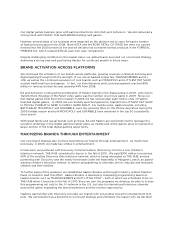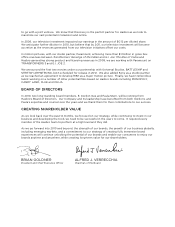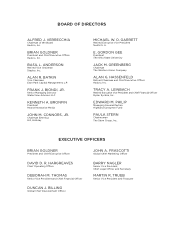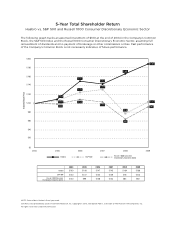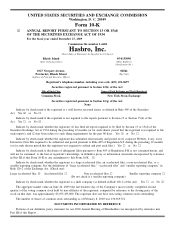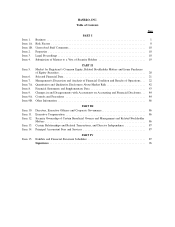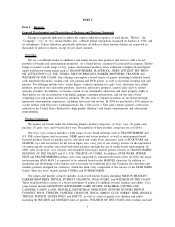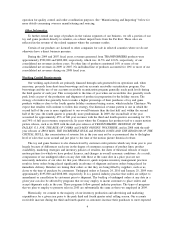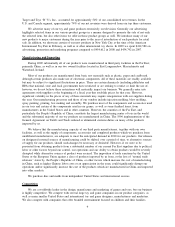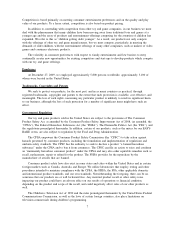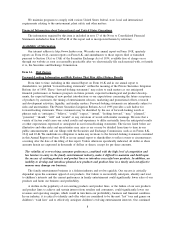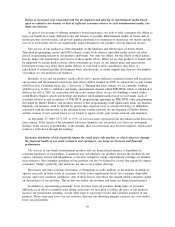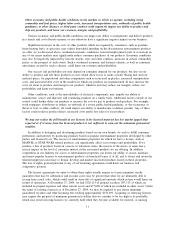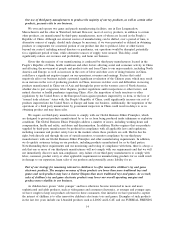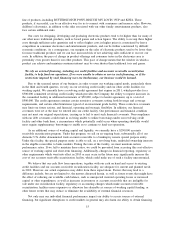Hasbro 2009 Annual Report Download - page 15
Download and view the complete annual report
Please find page 15 of the 2009 Hasbro annual report below. You can navigate through the pages in the report by either clicking on the pages listed below, or by using the keyword search tool below to find specific information within the annual report.
consumer demand in the holiday season. Due to the concentrated timeframe of this selling period, payments
for these accounts receivable are generally not due until later in the fourth quarter or early in the first quarter
of the subsequent year. The timing difference between expenses paid and revenues collected sometimes makes
it necessary for us to borrow varying amounts during the year. During 2009, we utilized cash from our
operations, borrowings under our revolving credit agreement as well as our uncommitted lines of credit, and
proceeds from our accounts receivable securitization program to meet our cash flow requirements.
Royalties, Research and Development
Our success is dependent on innovation, including both the continuing development of new products and
the redesign of existing products for continued market acceptance. Our toy, game and puzzle products are
developed by a global development group and the costs of this group are allocated to the selling entities which
comprise our principal operating segments. In 2009, 2008, and 2007, we spent $181,195, $191,424 and
$167,194, respectively, on activities relating to the development, design and engineering of new products and
their packaging (including products brought to us by independent designers) and on the improvement or
modification of ongoing products. Much of this work is performed by our internal staff of designers, artists,
model makers and engineers.
In addition to the design and development work performed by our own staff, we deal with a number of
independent toy and game designers for whose designs and ideas we compete with other toy and game
manufacturers. Rights to such designs and ideas, when acquired by us, are usually exclusive and the
agreements require us to pay the designer a royalty on our net sales of the item. These designer royalty
agreements, in some cases, also provide for advance royalties and minimum guarantees.
We also produce a number of toys and games under trademarks and copyrights utilizing the names or
likenesses of characters from movies, television shows and other entertainment media, for whose rights we
compete with other toy and game manufacturers. Licensing fees for these rights are generally paid as a royalty
on our net sales of the item. Licenses for the use of characters are generally exclusive for specific products or
product lines in specified territories. In many instances, advance royalties and minimum guarantees are
required by these license agreements. In 2009, 2008, and 2007, we incurred $330,651, $312,986 and $316,807,
respectively, of royalty expense. A portion of this expense relates to amounts paid in prior years as royalty
advances. Our royalty expenses in any given year vary depending upon the timing of movie releases and other
entertainment.
Marketing and Sales
As we are focused on re-imagining, re-inventing and re-igniting our many brands on a consistent global
basis, we have a global marketing function which establishes brand direction and messaging, as well as assists
the selling entities in establishing certain local marketing programs. The costs of this group are allocated to
the selling entities which comprise our principal operating segments. Our products are sold nationally and
internationally to a broad spectrum of customers, including wholesalers, distributors, chain stores, discount
stores, mail order houses, catalog stores, department stores and other traditional retailers, large and small, as
well as internet-based “e-tailers.” Our own sales forces account for the majority of sales of our products.
Remaining sales are generated by independent distributors who sell our products, for the most part, in areas of
the world where we do not otherwise maintain a direct presence. While we have thousands of customers, there
has been significant consolidation at the retail level over the last several years in our industry. As a result, the
majority of our sales are to large chain stores, distributors and wholesalers. While the consolidation of
customers provides us with certain benefits, such as potentially more efficient product distribution and other
decreased costs of sales and distribution, this consolidation also creates additional risks to our business
associated with a major customer having financial difficulties or reducing its business with us. In addition,
customer concentration may decrease the prices we are able to obtain for some of our products and reduce the
number of products we would otherwise be able to bring to market. During 2009, net revenues from our three
largest customers, Wal-Mart Stores, Inc., Target Corporation and Toys “R” Us, Inc., represented 25%, 13%
and 11%, respectively, of consolidated net revenues, and sales to our top five customers, including Wal-Mart,
5


